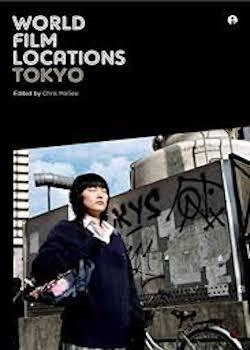World Film Locations: Tokyo

Edited by Chris MaGee
Intellect Ltd, October 2012
128 pages, ISBN 1841504831
Review by Michael Sullivan
For any fan of Japanese cinema, and with time to spare in Tokyo, this book is a must as it charts a journey of eighty years of movies being filmed in the great capital city of Japan. The editor Chris MaGee, who is the editor of the Toronto J-Film Pow-Wow Japanese film blog in Canada, includes contributions from 17 other writers in his book. The work covers 45 scenes from different movies that have featured Tokyo along with photos, maps and a short description. There are also seven articles which focus on different aspects of Japanese cinema.
The first section covers the period 1929-1960, in the description of each example scene we are also taken on a journey through cinema history, for example there is a description of how much footage is lost from before 1945 due to the highly flammable nitrate used for film stock, the damage Tokyo suffered in World War II and the film prints that were burned in the post war period by American censors. One surviving fragment of a movie from 1929 shows scenes of a Tokyo that has long since disappeared. It is only in the 1950s that more films exist which show buildings of the city that can still be seen today, one amusing example is the clock of the Wako Department Store in Ginza which features in the 1954 movie Gozilla (Gorija) and which doesn’t escape destruction.
From 1961 to 1978 we are given vivid reminders of major events in Tokyo’s history starting with the 1964 Tokyo Olympics and the route taken by the marathon runners which can be seen in Tokyo Olympiad. In conjunction with the Olympics the New Otani hotel in Chiyoda was built and opened in 1964, at this time this was the tallest building in Tokyo and three years later it would feature in the James Bond movie You Only Live Twice as the headquarters of an evil organisation. From personal experience from the restaurants at the top of this building there is still a lovely view of Tokyo as well as the nearby Akasaka Palace. Another moment from history is shown in the 1971 movie Throw Away Your Books and Rally In The Streets, in the 1960s protests by the nation’s youths were common and this movies shows the chaos in the streets.
The third section starts to bring this overview of Tokyo movie scenes up to date as the period 1979-1999 includes scenes from Tokyo Tower in the 1985 film Tokyo-Ga and also the animated movie Pom Poko. This Studio Ghibli movie was based on a real life area of Tokyo called Tama Hills which was redeveloped for human habitation and tells the fiction tale of the fight the raccoons (tanuki) fought to protect the shrinking forest. There is also another scene from Takeshi Kitano’s Kikujiro, as a young man he lived in the area of Asakusa and at the beginning of this film we are taken on a quick tour of this same place seen through the eyes of a boy.
As can be expected the final journey of Tokyo’s cinematic history brings us to the most recent, as well as iconic, movies such as Lost In Translation, Kill Bill, and The Taste of Fish (Tsukiji Uogashi Sandaime). Scenes from Pachinko parlours, bridges, bookshops and fish markets are shown, and of course all can be still seen today. For anyone interested in Japanese cinema and with an opportunity to visit Tokyo this book is a must buy. Not only does cinema bring a city to life, but it is a pleasure to see the same places with your own eyes.

